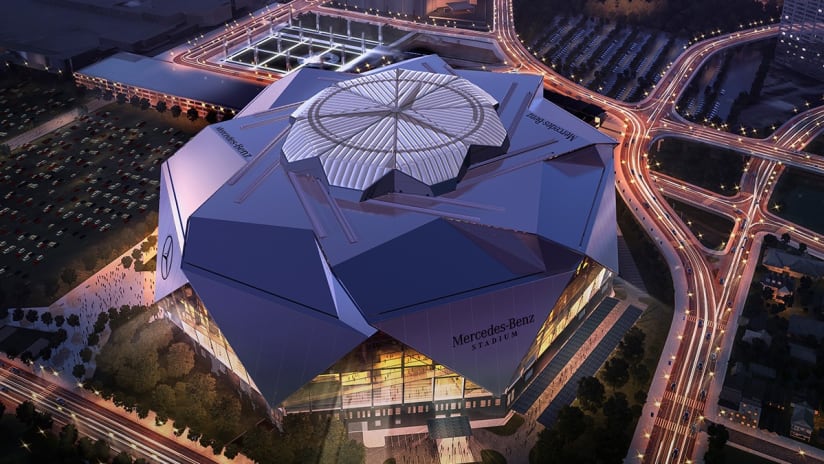Five MLS teams are moving into new homes in the next two years — and at least two will come with one added bonus for fans. In a first for the league, they’ll be able to stand for a full 90 in safe standing zones constructed specifically with supporters in mind.
Atlanta United FC and Minnesota United FC will start play in 2017 followed by LAFC in 2018, and the stadiums of all three MLS expansion teams are on track to help them cement new and unique identities. Meanwhile, teams with two of the oldest stadiums in MLS will level up to brand new stadiums. (That’s Orlando City SC, whose Camping World Stadium started life as a WPA project in 1936, and DC United, whose legendary, aging, full-of-soccer-history RFK Stadium opened in 1961.)
Atlanta United FC’s new home, Mercedes Benz Stadium, is being shared with the NFL’s Falcons, and its 71,000 capacity (expandable to 75,000) would at first appear to run counter to the soccer-specific stadium trend.
But Mercedes-Benz Stadium has taken cues from one of the league’s most recent dual-sport stadiums, Vancouver’s BC Place, in creating a mechanical curtain system that closes off the upper deck of stadium seating. That will hold Atlanta United FC’s seating to 40,000, but will also reduce the overall volume of the stadium for soccer rather than just cover up seats.
According to Scott Jenkins, general manager with Mercedes-Benz Stadium, that’s just one of a number of elements to make the stadium feel like home for the soccer team and its fans. The roof is retractable, but the stadium also is equipped with a drainage system, should the team opt to play in the elements. The stadium aso offers specific MLS locker rooms located to allow the long-standing soccer tradition of both teams walking onto the field side by side, as well as more fan-focused seating bells and whistles.
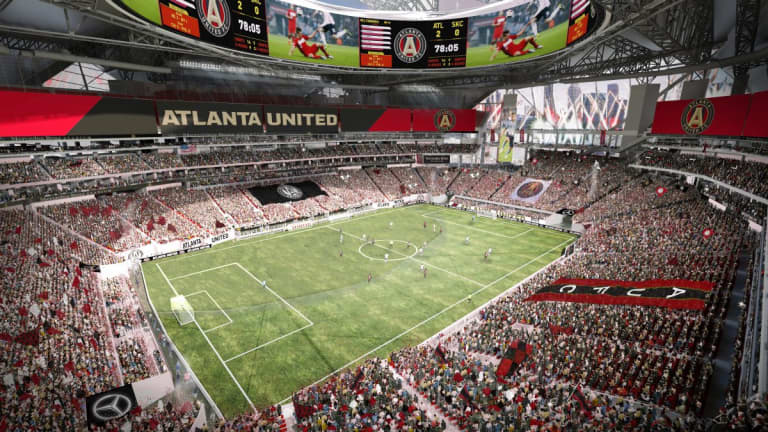
While this venue won’t feature a standing zone per se, there’s one additional feature that the Mercedes-Benz stadium spokesperson feels will be an added boon to soccer fans. It’s a sky bridge on the 200 level that is part of what the stadium is christening the “Window to the City.” The floor-to-ceiling window in the stadium’s northeast corner will provide additional light into the stadium and a view of the downtown Atlanta skyline -- and fans can gather there, standing, to watch the match.
Meanwhile, the other new entrant into MLS, Minnesota United FC, will take fan sections one step further by creating a safe standing zone supporters’ section for its new stadium, opening in St. Paul in 2018. According to team president Nick Rogers, there was simply “no reason not to” create a safe standing zone to accommodate the awesomely named Dark Clouds, who will add to their long tradition of supporting Minneapolis soccer teams with the incoming MLS team.
Inspired in part by the Yellow Wall, the famous safe standing zone at Borussia Dortmund’s Westfalenstadion home, the Minnesota United supporters’ section will accommodate 2,900 of the 20,000 fans that can fit inside the new stadium. While Rogers cites safety as one of the principal reasons for creating the South End standing section, he also notes, “Our supporters stand the whole time; they really have no use for seats.”
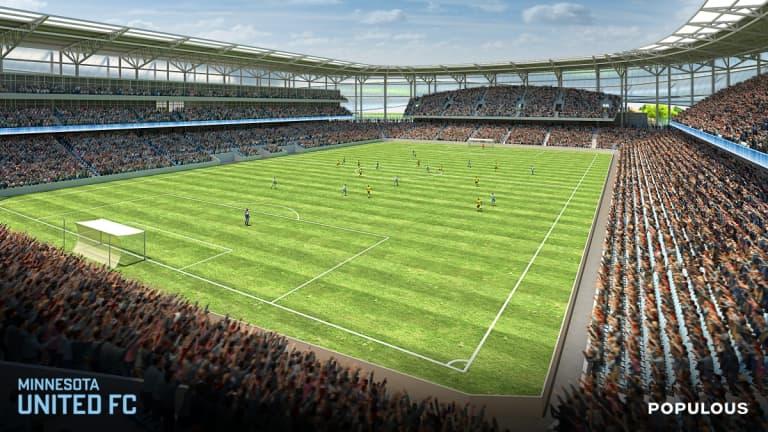
Rogers also says he’s excited about seeing the stadium’s translucent polymer mesh skin in action; its LED lights will allow the stadium to display color at night in what he terms a “dynamic and expressive” fashion. He’s already thinking of uses for it beyond just celebrating the team. “We would have had it light up in purple when Prince died, and would have had it red, white, and blue after the Paris attacks,” he said.
The stadium’s target date is 2018, though, so as other MLS teams have in the past, MNUFC will start life in a transitional home: TCF Bank Stadium, which opened in 2009 at the home stadium for the University of Minnesota Golden Gophers. “It lays out well for soccer,” Rogers says of the stadium, pointing out that it hosted an International Champions Cup doubleheader in 2014, and has the width necessary to contain an MLS regulation field.
So the first safe standing zone as part of a stadium's seating bowl will come into operation earlier than Minnesota’s -- namely, at the Orlando City SC stadium currently being built to open in time for Opening Day 2017. According to Orlando City SC president Phil Rawlins, fans have been involved in its design and creation from the outset.
Nearly 4,000 fans pitched in on an October 2014 groundbreaking, reminiscent of the October 2012 world-record-setting event that the Earthquakes staged for Avaya Stadium. Hundreds of fans also signed a purple steel beam at a series of events to become part of the stadium. (The beam is already in place, visible in its roofline.)
The safe standing zone in the stadium’s North End was seen, as it was in Minneapolis, as a way for supporters with no use for chairs to safely stand and cheer for their team. While the Earthquakes technically created the first safe standing zone in the league for its supporters with Avaya, theirs is on a level surface behind the endline but in front of the seating bowl. Orlando City, like MNUFC did, looked to Dortmund for inspiration in making a purple version of the high-sloped, massive Yellow Wall that unifies a great number of its fans.
“It’s a high angle, it provides a great vantage point for fans, it’s literally a wall,” Rawlins said, adding that it’s the safest way for fans who want to stand and be active while taking in a match. (It will also include two bars for supporters who want a quick trip to get refreshments.)
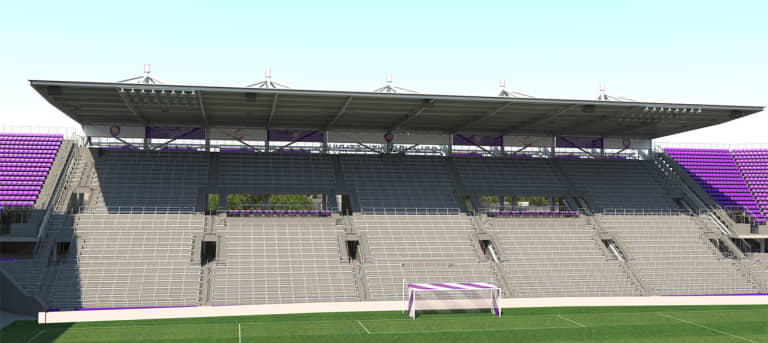
Orlando City SC supporters showed class and consciousness earlier this year in rainbow-themed tributes to those who lost their lives in the Pulse nightclub shooting, and the team’s creating an additional memorial as a permanent feature in the stadium. Forty-nine rainbow colored seats (one for each of the shooting victims) will be installed in Section 12 (for June 12, 2016, the date of the event).
“We wanted to do this to celebrate the lives of the people who died,” Rawlins says, “as well as paying tribute to those involved in saving lives of those wounded in the shooting, and everyone else who helped Orlando get through the tragedy.”
There is also one additional standing area in the stadium. As in Atlanta, it’s a gathering place designed for fans who want to trek from their assigned seats to meet up, with people or merely to get a different vantage point for part of the match. It’s on a terrace underneath the scoreboard dominating the southeast corner, and will give fans a view perched slightly above the field.
LAFC won't be joining the league until 2018, but the team's already at work on the already-named Banc of California Stadium, a 22,000-seat stadium that president and owner Tom Penn claims will be "transformational" not just for MLS, but globally. The stadium, next to the Los Angeles Memorial Coliseum just south of downtown, is a $350 million, privately-funded project that will include a "cultural center" with restaurants, event spaces, and conference facilities as part of the complex. The idea, according to Penn, is allow for year-round use of the complex rather than just banking on the finite number of home MLS dates each season.
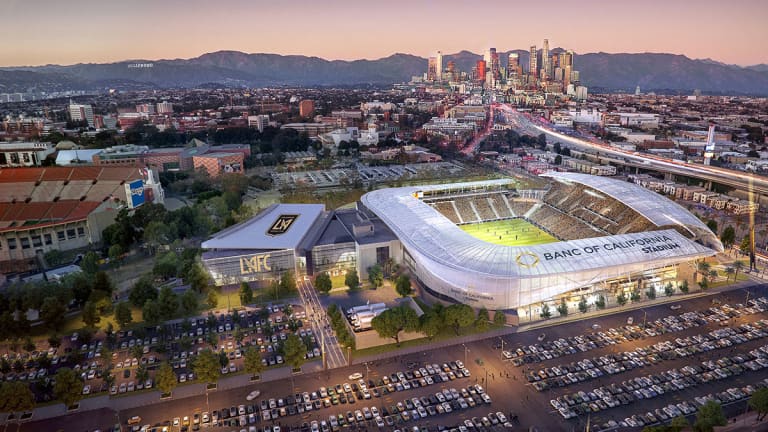
However, there is much thought going into how the stadium will function for soccer. The stadium's roof (covered in EFTE film) is being designed to "keep the sun off and the noise in," the seats will be set at a 34-degree slope akin to Avaya's configuration, and like Avaya, some of Banc of California's suites will be at field level—with the added bonus of no railings or separations, so those who pay for the privilege can literally have their feet on the grass at the edges of the field. The stadium's seating will be as close as 12 feet to the touchline, and the farthest seat will be a mere 135 feet from the pitch.
The club is involving LAFC supporters in discussions about how their home base in the stadium's north end will look. Details are developing as the stadium progresses toward its projected Spring 2018 opening, and planning includes the possibility of a safe standing zone, and there are already plans being put in motion for the supporters' bar that will be at the heart of the section. Fans of the new team already have made clear the essentials: Affordable beer, tacos, charging stations for smartphones, and a communal gathering place they can make their own. The team is also setting aside space for the supporters to store drums, tifo materials, and other essentials.
Of the five stadiums set to open in the next two years, D.C. United’s is the one with the most details yet to come. At the start of this month, Washington, D.C. officially transferred the Buzzard Point land -- where the stadium will be built -- over to the team. DCU spokesperson Lindsay Simpson says the planned stadium of nearly 20,000 should break ground on the stadium in the first quarter of 2017, and the team released renderings through its website last month that Simpson indicated were “close to final.”
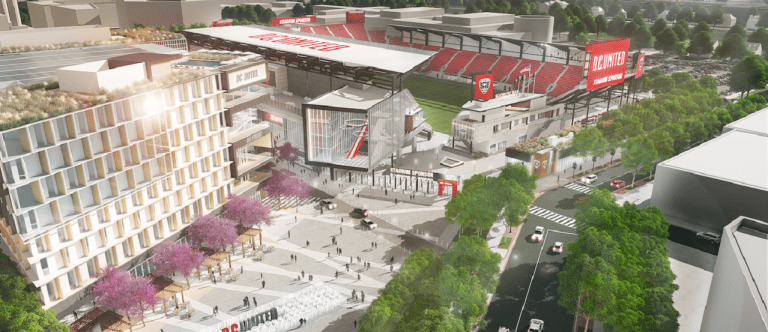
Stadium plans, as hinted at on the website, include a 65,000 square foot fan plaza outside the stadium, bike parking, and seats directly behind the goals — a feature missing at RFK. The venue is slated to open in June 2018, and the team is currently still talking about doing an extended road trip at the start of the 2018 season, as Toronto FC did this year while its stadium renovation project was wrapping up.
One thing that’s certain, Simpson says, is that 2017 will be the team’s final season at RFK, and the team will use the season to commemorate the 20-plus years at the stadium. Those two decades saw MLS’ first-ever champions, and offered, at RFK, a home for two supporters’ groups who were instrumental in defining American supporters’ culture. (RFK has also served as a de facto national stadium for the US Men’s National Team.)
Beyond that? Fans in Washington, D.C., like those in Atlanta, Minneapolis/St. Paul, Los Angeles and Orlando, will enjoy the excitement and the curiosity that comes from opening new doors.

